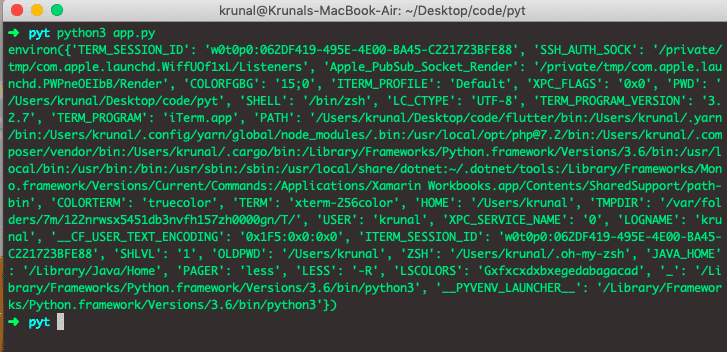Os system Continues When Stopping Script Os Module Python 2 7

Python OS module provides a way of using operating system dependent functionality. The functions that the OS module provides allow you to interface with the underlying operating system that Python is running on: be that Windows, Mac or Linux.
If you just want to read or write a file then use the open() function, if you want to manipulate paths, then use the os.path module, and if you want to read all the lines in all the files on the command line then use the fileinput module. For creating temporary files and directories, use the tempfile module, and for high-level file and directory, handling sees the shutil module.
The functions OS module provides us for operating on underlying Operating System tasks, irrespective of it being a Windows Platform, Macintosh, or Linux.
Python OS Module Example
The OS module in Python provides functions for interacting with the operating system. OS comes under Python's standard utility modules. The os module provides a portable way of using operating system dependent functionality. The *os* and *os.path* modules include many functions to interact with the file system.
The os module is the part of the standard library, or stdlib, within Python 3. This means that it comes with your Python installation, but you still must import it.
Write the following code to import theOS module.If you do not know what is a module in Python, then you can check out this Python Module article.
import os
Now, let's see some of the essential functions of os in detail.
#os.name
The os.name function gives the name of the OS module it imports. This differs based on the underlying Operating System.
# app.py import os print(os.name)
See the output.

#os.environ
Theenviron is not a function but a process parameter through which we can access the environment variables of the system.
Let's see the following example.
import os print(os.environ)
See the output.

We can also print the HOME environment.
# app.py import os print(os.environ['HOME'])
See the output.

#os.getcwd()
Thegetcwdfunction of the OS module will give us the current directory of the project.
# app.py import os print(os.getcwd())
See the output.

If you want to make a new directory type the following code.
# app.py import os os.mkdir('newDir') It will create a new directory callednewDirinside the current folder.
#os.execvp()
The execvp function is one of the ways to run other commands on the system. Let's see the following example.
Create one file inside the same folder calledmod.pyand add the following code.
# mod.py student = { 'name': 'Krunal', 'enno': 21, 'college': 'vvp college' } print(student) Now, write the following code inside theapp.pyfile.
# app.py import os program = 'python' arguments = ['mod.py'] print(os.execvp(program, (program,) + tuple(arguments)))
Now, run theapp.pyfile.
Output

#os.getgid()
It returns the real group id of the current process.
# app.py import os print(os.getgid())
It returns the20.That means the group id of the current process is 20.
#os.getuid()
Theos.getuid os module function returns the current process's user ID or UID, as it is popularly known.
See the following example.
import os print(os.getuid())
It returns the501.
#os.getpid()
Theos.getpidreturns the process ID of the current process.
# app.py import os print(os.getpid())
Output

#os.system
Python os system function allows us to run a command in the Python script, just as if I was running it in my shell. See the below example.
# app.py import os newFile = os.system('users > app.txt') If you run the aboveapp.pyfile, the new file is created calledapp.txtand inside thatkrunalis written because I am the user of my computer. You can see your name.
There are so many other OS modules that you can use in your project as per your requirement.
#os.error
All functions in this module raise OSError in the event of invalid or inaccessible file names and paths, or other arguments that have the correct type but are not trusted by the operating system. Python os.error is an alias for built-in OSError exception.
#app.py import os try: filename = 'omg.txt' f = open(filename, 'rU') text = f.read() f.close() except IOError: print('Problem reading: ' + filename) Output
➜ pyt python3 app.py Problem reading: omg.txt ➜ pyt
Finally, Python OS Module Example is over.
hartsellmorsitens.blogspot.com
Source: https://appdividend.com/2022/07/16/python-os-module/
0 Response to "Os system Continues When Stopping Script Os Module Python 2 7"
Postar um comentário